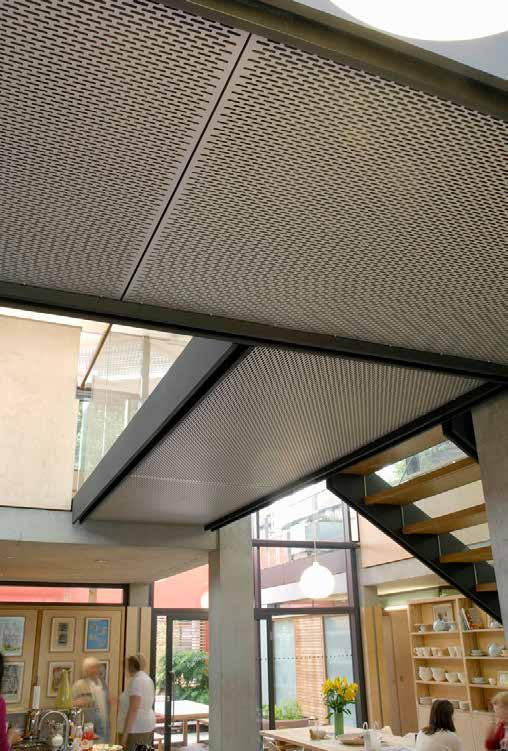ALUMINIUM
Perforated Sheet Patterns









This perforated aluminium sheet catalogue details the standard sheet sizes and patterns that we produce and stock.
There are also some inspirational images of projects where we have supplied our fabricated perforated products.
Our 5-Star Perforating Service accurately and rapidly produces perforated panels to meet your project specific requirements.
The following design elements can be included as part of a bespoke package.
•Made to order panel sizes
•Plain border margins or areas
•Cut outs to allow for M & E fixtures
•Return folds to panel edges
•Fixing holes in unperforated areas
•Folded edges to fit around design features
•Curved/rolled panels
•Pattern matching of holes to provide aesthetic continuity
•Apply powder coated finishes
Same day dispatch Sample Service.
Bespoke perforated panel sizes





























GA PSP656 2000 x
x 3.0mm 20% 6.5 GA PSP657




















































There is no substitute for viewing and handling the ‘real thing’.
Our Super Samples Service responds quickly and efficiently (within 24 hours) to perforated samples requests submitted via email (sales@goodingalum.com) or online www.goodingalum.com
Standard size samples are normally either 150 x 100mm or for the larger pattern sizes 150 x 150mm
Your samples are posted 1st Class in robust cardboard packaging, designed to ensure items are received in good condition.



















Blank areas/margins can be incorporated into specially perforated panels. Always check with our technical personnel to ensure the suitability of your perforated / plain layout before committing to specification.
Broken edges (absence of border margins) are not supplied by GA on standard stock size or specially perforated panels. Shearing to size from stock panels may result in broken edges.
Cleanliness on mill finish materials may vary from a relatively dry finish to a light residue of water soluble lubricant (necessary for the perforating process). It is advisable to arrange for mill finish materials to be wiped over on site, after installation.
End margins with staggered hole arrangements can result in either a finished or unfinished pattern at each end of the work piece.
Flatness in perforated sheets is never absolute. Factors including overall panel size, the ratio of perforated to plain areas, the % open area, material thickness, all effect the degree of distortion. Our technologically advanced production methods minimise these difficulties and help to produce commercially and visually acceptable degrees of flatness.
Hole size relative to material thickness is an important consideration. Avoid approaching a 1:1 ratio, i.e. 3.5mm hole dia in 3mm thickness. Instances of similar hole size and material thickness result in a less than satisfactory appearance and possibly tool breakage, causing production delays and other complications.
Ideal perforating material thicknesses from a quality processing point of view are between 1 and 3mm.
Short lead times can be provided from the selection of stock sheet configurations.
Increased rigidity can be designed into a perforated panel by increasing material thickness, incorporating a plain border, and / or a surround frame.
Material costs can be minimised by selecting from our range of standard hole size / shape configurations. Specially perforated panels can be produced economically and quickly. Bespoke hole layouts can involve longer lead times and new tooling charges.
Missing or imperfect hole shapes result from broken or damaged punches. This is not an unusual occurrence when perforating large numbers of small holes. It is standard industry practice to supply an acceptable % spoilage factor. GA policy aims to provide as near possible 100% complete perforations.

When specifying perforated ‘specials’ please confer with our Technical Sales Department before finalising a design. Various min / max production ratios apply to hole size, bridge distance, material thickness, end and side margins etc, which need to be observed to avoid possible material distortion and or fracture.
‘Open area’ in many applications, is of critical importance for reasons of air flow, screening etc. Please refer to the percentage open areas given for each GA standard pattern.
Quoted percentage open areas given in our website relate to the ratio of the total area of the holes to the area of perforated sheet, excluding the unperforated margins.
Plain margins on pre-punched sheets might or will be lost once sheared to size.
Polythene film on the punch face side only, is applied to help protect the material surface from the rigours of the perforating process.
Production tolerances for bespoke items incorporating perforations are less precise than for plain sheet working. Please refer to our GA5* Processing Standard for details.
Round holes with a 60˚ staggered pattern, are the most common hole arrangement, this is due to the inherent strength and wide range of available open areas.
Side margins should ideally be kept to an even dimension of less than 80mm, this helps to reduce surface camber and distortion.
Small quantities of ‘specials’ can often be economically and quickly produced by GA. Our bespoke software accurately calculates best use of materials and punching arrangements.
Standard size panels are shown with nominal overall dimensions, these can vary slightly depending on the necessity to ‘square’ sheets before perforating commences, and the degree of material ‘stretch’ during processing. Stock sheets are normally supplied with a minimum border margin.
The two sides of a perforated surface are not the same. The punch face side is where the punch enters the material and the burr side indicates the punch exit on the underside.
Visible faces should be indicated on unsymmetrical panels and fabrications as the punch face side is superior to the burr (underside). It is advisable to avoid specifying mill or anodised finishes when both sides of the sheet are to be closely viewed. Powder coating minimising these difficulties.
Square holes provide good visibility and air flow while providing decorative cover. Staggered patterns for rounds and squares will normally be the short dimension of the sheet. The straight row of holes is usually parallel to the sheet length

